What side do you pour wine on?
A sommelier should pour wine from the right side of the guest, keeping their left hand behind their back. The wine should flow smoothly without any splashing. To avoid the glass touching the bottle's neck, the sommelier may discreetly wipe the bottleneck with a napkin.
What is a standard wine pour?
A standard pour is generally 5 ounces or 150 mls (that's five glasses to every 750 ml bottle). However, some restaurants will pour as much as 6 ounces (180mls), while others may offer slightly less, depending on pricing and wine type.
Does wine taste better in a wine glass?
Indeed, the shape of your wine glass can impact the wine's flavour. Different glass shapes and temperatures can enhance various aspects of a wine’s bouquet and finish. A glass designed for red wine helps concentrate the aromas, improving the overall tasting experience.
Is it okay to refrigerate red wine?
While white wines are commonly stored in the fridge, red wines can also benefit from slight chilling, especially in warmer climates. Generally, red wine is best enjoyed at room temperature, but slightly chilling it can help if it's particularly warm. The temperature can significantly affect the wine's flavour profile, as seen in varying climates from a European summer to a Queensland summer.
How do you price a glass of wine?
First, let's talk about wine by the glass. As a rule, the cost of a glass of wine is going to cost exactly what the restaurant paid for the bottle. So, if they paid $10, that wine by the glass will cost $10. With 4-5 pours in a bottle, that means the restaurant takes in a nice profit of $30 to $40 per bottle - to help cover service and overheads.
What is the best way to store red wine?
Proper storage is crucial for maintaining the quality of red wine:
- Store bottles on their sides to keep the cork moist.
- Keep the wine in a dark place to avoid light damage.
- Maintain a constant temperature, ideally between 12-18°C.
- Ensure moderate humidity and minimise movement.
How long does red wine last opened?
Opened red wine generally lasts 3–5 days when stored in a cool, dark place with a cork. Wines with higher tannin and acidity, such as Cabernet Sauvignon, tend to last longer than lighter reds like Pinot Noir.
Does red wine go bad?
High-quality red wines can age well for decades, while cheaper varieties are best consumed within a few years. Once opened, red wine deteriorates quickly, typically within a week, due to oxidation.
What do wine tears mean?
Wine tears, or legs, are the droplets that form and slide down the inside of a glass. This phenomenon is linked to the wine’s alcohol content and viscosity, not its quality.
Why do you swirl a wine before tasting it?
Swirling wine introduces oxygen, which helps release the wine’s aromas. This process enhances the tasting experience by allowing you to better appreciate the wine’s bouquet.
Is wine good for your stomach?
Research suggests that red wine, particularly Merlot, can positively affect gut bacteria due to its polyphenol content. The health benefits are attributed more to these compounds than to the alcohol itself.
The healthiest red wines
Some red wines are known for their health benefits:
- Pinot Noir
- Syrah/Shiraz
- Merlot
- Cabernet Sauvignon
- Rosé
Wine facts and storage
- On average, two people can finish a 750 ml bottle of wine in about 2.5 hours
- A 750 ml bottle of wine is equivalent to 25.36 ounces
- Drinking a bottle of wine weekly over a lifetime amounts to roughly 2,970 bottles
- Consuming a glass of wine nightly throughout adulthood totals around 4,160 bottles
- A bottle of wine contains approximately 750 calories
- Dry wines have zero fat and 0-2 grams of carbs, while sweet wines range from 3 to 39 grams of carbs.
Enhance your wine experience with Protech's dynamic wine fridges
Ensure your wine is always stored under ideal conditions with Protech's exceptional range of wine fridges. Our expert advisors are ready to assist you with any questions and help you choose the perfect fridge for your needs. Contact us today to explore our collection and elevate your wine storage experience.







-160x160-state_article-rel-cat.png)






-160x160-state_article-rel-cat.png)



-160x160-state_article-rel-cat.png)


















